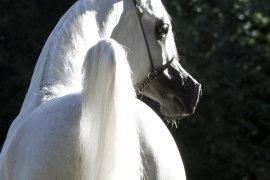Below is a short guide to the various types of fibrous foods that can be given to horses: grazing grass, hay, ensiled foodstuff, straw, molichaff, artificially dried grass, enriched forage and complete foods.
Grazing grass is probably the best forage that can be given to a horse, especially in springtime, when it is rich in precious nutrients and is not too fibrous. The horse must be led to a sufficiently large grazing area where he can avoid the unwanted grass (which will have to be removed in some way, usually by sickling the grass before seeds are formed, so as to avoid their gradual colonization of the meadow) and choose the best ones.
The horses grazing on well kept grass are protected from many shortages and are usually calm, because the time dedicated to grazing has a beneficial effect on their temperament.
The composition of grazing grass is not always the same, and especially in late fall and winter the nutritional value decreases significantly. That is why, even if the horse grazes in vast areas, it is always necessary to compensate in winter with preserved forage or fodder.
In one day a horse can go through a staggering 50kg or more of grass! The horses grazes many times a day at short intervals, which solves the problem of the small stomach (usually with a capacity of 15 liters of slightly more). In addition, 80% of the weight of grass is represented by water (the percentage in hay decreases to 15%), so the feeding requires grazing in large quantity.
Grass sickled and given to a stable horse keeps its nutritional values almost unchanged, but this type of feeding makes the choice of grass more difficult and dramatically reduces consumption times. For this reason, grass in everyday practice is considered dangerous, to be given cautiously.








